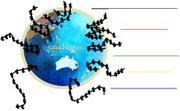Country Informations about Australia (february)
Parliament House in Canberra was opened in 1988 replacing the provisional Parliament House building opened in 1927.
The Commonwealth of Australia is a constitutional monarchy with a parliamentary system of government. Queen Elizabeth II is the Queen of Australia, a role that is distinct from her position as monarch of the other Commonwealth Realms. The Queen is represented by the Governor-General at Federal level and by the Governors at State level. Although the Constitution gives extensive executive powers to the Governor-General, these are normally exercised only on the advice of the Prime Minister. The most notable exercise of the Governor-General's reserve powers outside the Prime Minister's direction was the dismissal of the Whitlam Government in the constitutional crisis of 1975.
There are three branches of government:
• The legislature: the Commonwealth Parliament, comprising the Queen, the Senate, and the House of Representatives; the Queen is represented by the Governor-General, whose powers are limited to assenting to laws.
• The executive: the Federal Executive Council (the Governor-General as advised by the Executive Councillors); in practice, the councillors are the Prime Minister and Ministers of State.
• The judiciary: the High Court of Australia and other federal courts. The State courts became formally independent from the Judicial Committee of the Privy Council when the Australia Act was passed in 1986.
The bicameral Commonwealth Parliament consists of the Queen, the Senate (the upper house) of 76 senators, and a House of Representatives (the lower house) of 150 members. Members of the lower house are elected from single-member constituencies, commonly known as 'electorates' or 'seats'. Seats in the House of Representatives are allocated to states on the basis of population. In the Senate, each state, regardless of population, is represented by 12 senators, while the territories (the ACT and the NT) are each represented by two. Elections for both chambers are held every three years; typically only half of the Senate seats are put to each election, because senators have overlapping six-year terms. The party with majority support in the House of Representatives forms Government, with its leader becoming Prime Minister.

There are three major political parties: the Labor Party, the Liberal Party and the National Party. Independent members and several minor parties — including the Greens and the Australian Democrats — have achieved representation in Australian parliaments, mostly in upper houses. Since the 1996 election, the Liberal/National Coalition led by the Prime Minister, John Howard, has been in power in Canberra. In the 2004 election, the Coalition won control of the Senate, the first time that a party (or coalition of governing parties) has done so while in government in more than 20 years. The Labor Party is in power in every state and territory. Voting is compulsory for all enrolled citizens 18 years and over in each state and territory and at the federal level.







Aucun commentaire:
Enregistrer un commentaire